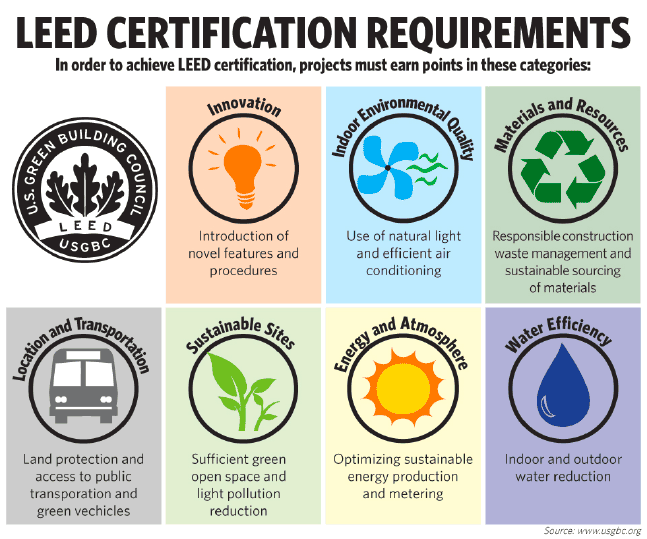What is LEED?
Sustainability is a hot topic in the construction industry right now, architects want to create LEED certified environmentally friendly buildings, material suppliers want to demonstrate how their products are green and progressive, and end users want to know that their facility is at the cutting edge of sustainable technology.
To this end, suppliers, builders, architects and owners will all frequently tout the green credentials of their products/services/facilities as loudly as possible.
The big name that many will use to support these claims is LEED®, or Leadership in Energy and Environmental Design, a rating system set up by the U.S. Green Building Council (USGBC) to assess the environmental credentials of a building, and validate sustainable building strategies and practices used in the design, construction and operation of said building.
Don’t Believe the Hype: Building Materials are NOT LEED Certified!
However, it is important to bear in mind that despite many advertising slogans and marketing to the contrary, specific building systems and materials are not themselves LEED-certified – they can help building owners achieve LEED credits that then count toward LEED certification but this doesn’t make them “certified” in and of themselves.
And it is not as simple as just getting enough credits to be certified. Before examining which credit strategies will earn points for a project, which then determines which certification level a building falls into, it must first meet all LEED prerequisites. While the credits that developers want to pursue are designed to be flexible and offer a number of options, the prerequisites can’t, these are the bare minimum that buildings need to meet in order to be eligible for LEED certification.
For example, “construction activity pollution prevention” is a prerequisite that requires projects to implement plans to reduce pollution by controlling soil erosion, waterway sedimentation and airborne dust.
Once the prerequisites have been met, you can look at the credits the project can achieve. The different credit options are grouped together into various categories, such as Location & Transportation, Material & Resources and Indoor Environmental Quality.

How are Buildings Awarded Credits?
Different project types will have different credit options available to them, but so long as your project fits within that LEED category, developers are free to go for whichever credits they like. The credits have been devised in such a way that particular ones will pair well with other prerequisites or credit options to provide synergistic benefits.
The point scoring credits can range from one-pointers such as the “clean construction” option, which requires the implementation of a plan to reduce particulate matter emissions from vehicles, equipment and power generation. In the middle of the spectrum are categories like “innovation”, which can award five points if the project can prove “significant, measurable environmental performance using a strategy not addressed in the LEED green building rating system”.
At the higher end of the scale are options such as “optimize energy performance”, which sits in the Energy & Atmosphere section of the LEED Scorecard. The intention of this credit is to “increase levels of energy performance beyond the prerequisite standard to reduce environmental and economic harms associated with excessive energy use”.
LEED has a number of certification levels depending on how many points your credits have built up. The different levels are:
- Certified (40-49 points)
- Silver (50-59 points)
- Gold (60-79 points)
- Platinum (80 + points)
On the USGBC’s website you’ll find a long list of the prerequisites, credits and points categories.
As it is not necessarily what the product is, but what outcome it will help to achieve, it is important to ask not whether a product is certified (because it never will be) but instead, will I earn LEED credits by choosing this building material and will it fit in with the credits I have chosen to target?
Beware: With LEED One Size Does Not Fit All!
Bear in mind that developers cannot assume that a product they’ve previously chosen will help to accrue the same amount of LEED credits. This is because LEED is not a static qualification, and in fact it is currently on its fourth edition. The guidelines transitioned to LEED v4 on Oct. 31, 2016 and saw several significant changes to how some types of products are evaluated. This means that the rules governing a particular product may have changed since the last time it was used.
For example, the latest version of LEED (LEED v4) has an increased focus on indoor environmental quality and the impact that several categories of materials, including flooring, have on it. This in turn affects the number of points that can be accrued via the specified floor, as systems that are detrimental to the building’s interior and inhabitants will make it harder to achieve LEED certification.
It is important to thoroughly discuss with the product’s manufacturer how the properties of a specific building material will help or hinder the overall total of LEED credits. Especially as you may need to know specific information about the manufacturer’s operations, such as: How far has the product travelled? How is it formulated? How is it installed? And will it maintain its green properties for the long term?
If you are interested in finding out more about the guidelines head to the LEED section of the USGBC’s website and if you’d like to learn more about flooring solutions that will help to achieve LEED certification why not talk to your local Flowcrete expert, who will be able to advise on systems that meet the functional, aesthetic, budgetary and sustainability requirements of your development.





